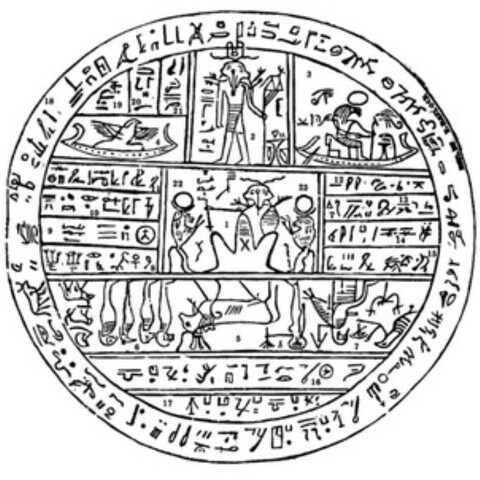The Book of Abraham is believed by members of The Church of Jesus Christ of Latter-day Saints to be “an inspired translation of the writings of Abraham. Joseph Smith began the translation in 1835 after obtaining some Egyptian papyri. The translation was published serially in the Times and Seasons beginning March 1, 1842, at Nauvoo, Illinois” (Pearl of Great Price Introduction).
Canonized as scripture by the Church in 1880, the Book of Abraham teaches important doctrinal truths about the Abrahamic covenant and the plan of salvation. It also narrates an account of the patriarch Abraham’s near-sacrifice at the hands of his idolatrous kinsmen in Ur of the Chaldees, his journey into Canaan, the covenant he made with God, and his vision of the pre-mortal world and the Creation.
Since at least the 1960s, Latter-day Saint scholars have explored the text of the Book of Abraham to see what clues might exist that situate it in a plausible ancient setting. These efforts, in conjunction with ongoing progress in the fields of Egyptology and Near Eastern archaeology, have uncovered numerous points of convergence between the text and the ancient world. These various lines of evidence do not “prove” the Book of Abraham is true, but they do help us situate the text in a plausible ancient environment, inform how we read the text, and positively impact our evaluation of Joseph Smith’s claims to prophetic inspiration.
Here are just five of the many remarkable convergences between the Book of Abraham and the ancient world.
1. Sobek, The God of Pharaoh
The opening chapter of the Book of Abraham identifies “the god of Pharaoh” as being one of the idolatrous gods worshipped by Abraham’s kinsmen (Abraham 1:6, 9, 13, 17). In Figure 9 of Facsimile 1 of the Book of Abraham, this god is depicted as a crocodile. Is there any evidence who this god might have been and whether he was worshipped in Abraham’s lifetime (circa 2,000–1,800 BC)? In fact, a strong case can be made for identifying the “god of Pharaoh” in the Book of Abraham as the Egyptian deity Sobek.
This god was worshipped even before Abraham’s day and was commonly depicted as either a crocodile-headed man or a full crocodile wearing a crown. Anciently “he was regarded as a powerful deity with several important associations,” among them “procreative and vegetative fertility” and, importantly for the Book of Abraham, “the Egyptian king . . . as a symbol of pharaonic potency and might.”
To read more, see “Sobek, The God of Pharaoh.”
2. The Idolatrous God of Elkenah
The Book of Abraham tells how Abraham’s kinsmen worshipped idols. One of these was the god of Elkenah (Abraham 1:6). When Abraham preached against the worship of this god, he said that his kinsmen “hearkened not unto [his] voice, but endeavored to take away [his] life by the hand of the priest of Elkenah” (v. 7).
What do we know about the ancient god Elkenah? No deity of that name is mentioned in the KJV Bible, but in the last century archaeologists have unearthed evidence of his worship.
Elkenah is very likely the shortened form of the name of the Canaanite god El koneh aratz, meaning “God who created the earth” (or “God, creator of earth”). Among the ancient Hittites living in Asia Minor he was known as Elkunirsha.
To read more, see “The Idolatrous God of Elkenah.”
3. Human Sacrifice
The Book of Abraham begins with an account of the biblical patriarch Abraham almost being sacrificed to “dumb idols” and “strange gods” (Abraham 1:7–8). The form of sacrifice practiced by Abraham’s kinsmen in Ur (vv. 8, 13) was said to be “after the manner of the Egyptians” (vv. 9, 11), and indeed a “priest of Pharaoh” was involved in this procedure (vv. 7–8, 10).
This raises the question of whether the ancient Egyptians ever practiced “human sacrifice.” While scholars might disagree on what precise terminology to use, there is, in the words of one Egyptologist, “indisputable evidence for the practice of human sacrifice in classical ancient Egypt.” Some of the evidence for this practice dates to the likely time of Abraham (circa 2,000–1,800 BC). “The story presented in the Book of Abraham matches remarkably well with the picture of ritual slaying” in Egypt during the same time period, concludes two Egyptologists in a study of this evidence.
To read more, see “Human Sacrifice.”
4. Abraham and Idrimi
The Book of Abraham narrates the life of the biblical patriarch in a first-person autobiographical voice. The book begins: “In the land of the Chaldeans, at the residence of my fathers, I, Abraham, saw that it was needful for me to obtain another place of residence” (Abraham 1:1).
This first-person voice continues throughout the text as if Abraham himself was writing.
When the Book of Abraham was published in 1842, no other texts from a similar time and place were known. The Book of Abraham was unique in that respect. In the last nearly 200 years, archaeology has uncovered more texts that we can compare with the Book of Abraham.
One such ancient text discovered in 1939 contains strikingly similar features with the Book of Abraham. It too is an “autobiography” in that it narrates a story in the first-person. It speaks of a ruler named Idrimi who lived in ancient Syria—which is in the vicinity of one very plausible candidate for Abraham’s homeland—not long after the likely time period of Abraham (circa 2,000–1,800 BC). “Idrimi’s autobiography compares well with Abraham’s autobiography in both subject and form,” explains scholar John Gee.
To read more, see “Abraham and Idrimi.”
5. The Plain of Olishem
The opening chapter of the Book of Abraham mentions a location named “the plain of Olishem” (Abraham 1:10). It isn’t clear from the text whether the plain itself was Olishem or whether some city or region in the area to which the plain was adjacent was Olishem or if the plain takes its name from a major city on the plain. In any case, this “plain of Olishem” was near Abraham’s homeland of Ur of the Chaldees according to the Book of Abraham.
In 1985, a Latter-day Saint archaeologist named John M. Lundquist published a pioneering article situating the Book of Abraham in a plausible ancient geographical and cultural environment in northern Mesopotamia. Among the points discussed by Lundquist was the plausible identification of Olishem with the ancient place name Ulisum (or Ulishum). Lundquist pointed to inscriptional evidence dating to the time of the Akkadian king Naram Sin (who reigned circa 2254–2218 BC) which spoke of Ulisum in what is today northern Syria or southern Turkey.
Subsequent studies have built upon and strengthened this enticing identification of Olishem in the Book of Abraham as the ancient Ulisum. In fact, one non-Latter-day Saint archaeologist working in the area has favorably suggested a possible (though inconclusive) connection between Olishem and Ulisum on linguistic, chronological, and geographical grounds. In 2013, excavators at the Turkish site of Oylum Höyük near the Syrian border announced that it was the ancient Ulisum mentioned in the inscription of Naram Sin and identified it as “the city of Abraham.” To see the proposed location of Abraham’s Olishem, click on this Google map link here.
To read more, see “The Plain of Olishem.”
As with all other books of scripture, the truthfulness of the Book of Abraham is best determined through prayerful study of the text and receiving a confirmatory witness by the Holy Ghost. However, evidence such as the five points discussed above may help readers have more confidence in the text as they investigate it claims and may otherwise enrich study of the text by those who already accept it as authentic scripture.
Lead images from ChurchofJesusChrist.org
This article has been adapted from material appearing originally on PearlOfGreatPriceCentral.org. Want to be kept in the loop about more amazing scriptural insights? Sign up for our free updates at https://bookofmormoncentral.org/content/subscribe.



